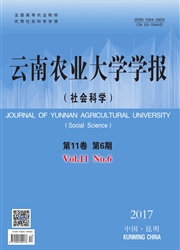

 中文摘要:
中文摘要:
在西双版纳热带雨林中,对叶榕Ficus hispida的传粉榕小蜂Ceratosolen solmsi marchali不同运载花粉过程对寄主榕果和自身后代的繁殖都有影响。对叶榕传粉榕小蜂主动地为对叶榕传粉,在雌株上的榕果内,雌花受精发育成种子,没有榕小蜂寄生繁衍;在雄株上的榕果里则只榕小蜂而没有种子。从雄花期榕果内出来的传粉榕小蜂雌蜂,飞到其它雌树上寻找雌花期的榕果传粉,一只雌蜂在一个榕果传粉产生种子(810.38±235.13)粒,平均种子形成率是0.41%。通过控制实验阻断繁殖雌蜂的飞行过程,一只雌蜂在一个榕果传粉产生种子(1124.05±281.41)粒,平均种子形成率是0.56%。飞行运载花粉的代价为直接减少了传粉榕小蜂给榕果传粉产生种子的数量。通过控制实验阻断繁殖雌蜂的飞行过程,并且不让雌蜂携带花粉,榕果在8—12d全部掉落,产生的种子数是0个,种子形成率0。用在雄株周围飞翔的小蜂进行放蜂,一只雌蜂在一个榕果传粉产生种子(1012.20±271.97)粒,平均种子形成率为0.50%。
 英文摘要:
英文摘要:
It was studied that the process of carrying pollen by fig wasp ( Ceratosolen solmsi marchali) in Ficus hispida caused different effects on the reproduction of F. hispida and the wasp itself in the tropical rainforest of Xishuangbanna. The wasps were active pollinators. Female flowers were fertilized and developed into seeds, wasp didn't live in it. However, figs in male plants accommodated only fig wasps instead of producing seeds. Then the foundress left male-floral fig and flied to another female plant to look for receptive female fig and to pollinate. A fig with a foundress inside would produce (810.38 ±235. 13) seeds, the rate of seed bearing was 0. 41%. A fig pollinated by a foundress which pollinated without flying would produce ( 1 124.05± 281.41 ) seeds, the rate of seed bearing was 0. 56%. It was implied that the cost of carrying pollen and fly was decreased the seeds. When we use the foundress without carrying pollen and flying to pollinate the figs, all figs dropped in 8 - 12 d, and all the figs produced no seeds. Using the wasp flying around the male plant to pollinate the figs, a fig produced (1 012. 20±271.29) seeds, the rate of seed bearing was 0.50%.
 同期刊论文项目
同期刊论文项目
 同项目期刊论文
同项目期刊论文
 期刊信息
期刊信息
